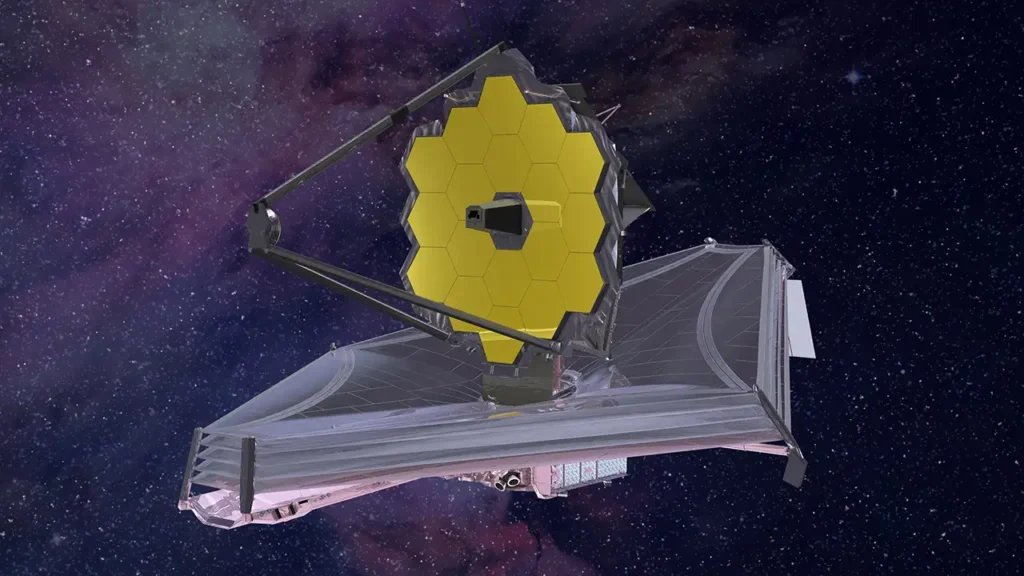James Webb Space Telescope (JWST) Mission Overview
The James Webb Space Telescope (JWST) is NASA’s premier space observatory, designed to revolutionize our understanding of the universe. It is a collaboration between NASA, the European Space Agency (ESA), and the Canadian Space Agency (CSA) and serves as the scientific successor to the Hubble Space Telescope.

1. Mission Objectives
JWST is designed to answer some of the most profound questions in astrophysics, with four primary scientific goals:
- First Light & Reionization – Investigate the formation of the first stars and galaxies after the Big Bang.
- Galaxy Evolution – Study how galaxies form, merge, and evolve over cosmic time.
- Star and Planet Formation – Examine the birth of stars and planetary systems, including protoplanetary disks.
- Exoplanet Characterization – Analyze the atmospheres of exoplanets, searching for conditions that support life.
2. Key Features
- Infrared Observatory – Unlike Hubble, which primarily observes in visible and ultraviolet light, JWST is optimized for the infrared spectrum, allowing it to see through dust clouds and detect extremely distant objects.
- Primary Mirror – A massive 6.5-meter (21.3 feet) segmented mirror, made of beryllium and coated with gold, providing unparalleled sensitivity.
- Sunshield – A tennis court-sized, five-layer sunshield that protects the telescope from heat and allows it to maintain cryogenic temperatures.
- Location – JWST orbits the Sun-Earth Lagrange Point 2 (L2), about 1.5 million km (1 million miles) from Earth, where it can stay cool and have an unobstructed view of space.
3. Instruments
JWST carries four major scientific instruments:
- Near Infrared Camera (NIRCam) – Captures high-resolution infrared images of galaxies, nebulae, and exoplanets.
- Near Infrared Spectrograph (NIRSpec) – Splits light into spectra to study the chemical composition of distant objects.
- Mid-Infrared Instrument (MIRI) – Extends JWST’s reach into the mid-infrared, allowing it to study cooler celestial objects.
- Fine Guidance Sensor / Near InfraRed Imager and Slitless Spectrograph (FGS/NIRISS) – Helps with precision pointing and exoplanet characterization.
4. Launch & Deployment
- Launch Date: December 25, 2021
- Launch Vehicle: Ariane 5 rocket
- Launch Site: Guiana Space Centre, Kourou, French Guiana
- Deployment Process: Over the course of 30 days, JWST completed a complex unfolding sequence, deploying its mirror and sunshield.
5. Major Discoveries & Contributions
Since its first images were released in July 2022, JWST has already made groundbreaking discoveries, including:
- Identifying some of the earliest galaxies ever observed, formed less than 300 million years after the Big Bang.
- Detecting carbon dioxide in the atmosphere of an exoplanet for the first time.
- Revealing the detailed structures of nebulae, including the Pillars of Creation and the Tarantula Nebula.
- Observing gravitational lensing to detect galaxies from the very early universe.
6. Future Prospects
JWST is expected to operate for at least 20 years, far exceeding its original 10-year goal. As new scientific techniques and missions emerge, it will continue revolutionizing fields such as cosmology, planetary science, and the search for life beyond Earth.
Final Thoughts
JWST is humanity’s most powerful space telescope, capable of seeing deeper into the universe than ever before. It is already rewriting textbooks and will continue to do so for decades, offering insights into the origins of stars, planets, and life itself.